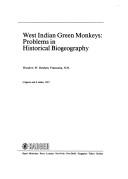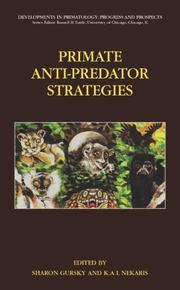| Listing 1 - 5 of 5 |
Sort by
|
Article
Abstract | Keywords | Export | Availability | Bookmark
 Loading...
Loading...Choose an application
- Reference Manager
- EndNote
- RefWorks (Direct export to RefWorks)
Stainless steel circular mirrors were employed in an enrichment plan for 105 singly housed male African green monkeys. We observed 25 randomly selected males to measure mirror use and to assess the mirrors' effectiveness as an enrichment item. We conducted additional mirror-use surveys on all 105 males using fingerprint accumulation as an indicator (rated on a scale of 0 to 4). Use was defined as either being in contact with the mirror (contact use (CU)) or looking directly into the mirror without contact (non-contact use (NC)). Mirror-use data were collected 10 months after the initial introduction of the mirrors and again at 16 months. The two time points were compared by paired t-tests. No significant difference in use was found between the two data collection points. On average, the monkeys used the mirrors 5.2% of the total time intervals recorded (approximately 3 min/hr). Results from the five fingerprint-accumulation surveys showed that 102 of 105 males (97%) had CU with their mirrors over the survey points. Based on the sustained use of the mirrors over a 6-month period, we concluded that the mirrors were an effective enrichment tool that the vast majority of our monkeys routinely used. Habituation did not appear to occur even a year after the mirrors were introduced. (C) 2004 Wiley-Liss, Inc
African green monkey. --- Chimpanzees. --- Collection. --- Contact. --- Enrichment. --- Environmental enrichment. --- Habituation. --- Male. --- Males. --- Mirror. --- Mirrors. --- Monkey. --- Monkeys. --- Resources. --- Rhesus macaques. --- Survey. --- Time. --- Tool.

ISBN: 3805545185 Year: 1987 Publisher: Basel München Paris Karger
Abstract | Keywords | Export | Availability | Bookmark
 Loading...
Loading...Choose an application
- Reference Manager
- EndNote
- RefWorks (Direct export to RefWorks)
Cercopithecus aethiops. Migratie. Geschiedenis. --- Cercopithecus aethiops. West-Indië. --- Cercopithecus aethiops. Répartition géographique. --- Cercopithecus aethiops. Migrations. Histoire. --- Cercopithecus aethiops. Indes occidentales. --- Cercopithecus aethiops. Aardrijkskundige verspreiding. --- Cercopithecus aethiops --- Mammal populations --- Mammals --- Eutheria --- Mammalia --- Mammalians --- Prototheria --- Theria --- Vertebrates --- Vertebrate populations --- Cercopithecus pygerythrus --- Cercopithecus sabaeus --- Cercopithecus tantalus --- Green monkey --- Grivet monkey --- Savanna monkey --- Vervet monkey --- Cercopithecus --- Geographical distribution --- Migration
Book
Year: 2020 Publisher: Basel, Switzerland MDPI - Multidisciplinary Digital Publishing Institute
Abstract | Keywords | Export | Availability | Bookmark
 Loading...
Loading...Choose an application
- Reference Manager
- EndNote
- RefWorks (Direct export to RefWorks)
Leptospirosis is a worldwide-distributed, re-emerging zoonosis due to the large variety of wild and domestic animal species that can play the role of natural or accidental host. Currently, specific animal species play an important role as reservoirs for particular Leptospira serovars, although recent investigations have highlighted new host–pathogen interactions involved in Leptospira epidemiology. Furthermore, the constant modification of ecosystems and wildlife habitats and the constantly increasing number of animal species moving towards urban or peri-urban areas are increasing the possibility of direct or indirect contact between wildlife and domestic animals; furthermore, the constant modification of animal leptospirosis also causes problems for human health. The studies published in this book have evidenced and confirmed the hidden role of a large variety of animal species, domestic and wild, in leptospirosis epidemiology. They highlighted the necessity for continuous monitoring and large-scale surveillance studies to better understand this neglected and re-emerging zoonosis.
Research & information: general --- Biology, life sciences --- Leptospirosis --- pig --- MAT --- real-time PCR --- genotyping --- epidemiology --- Australis --- canine leptospirosis --- Icterohaemorrhagiae --- multi-locus sequence typing --- leptospirosis --- zoonosis --- infectious disease --- multilocus sequence typing (MLST) --- wildlife --- Leptospira fainei --- intermediate Leptospira --- Leptospira spp. --- cattle --- abortion --- pathology --- non-maintenance serovars --- PCR --- lfb1-phylogeny --- Leptospira --- African green monkeys --- Caribbean --- renal lesions --- dog --- multilocus sequence typing --- multiple loci variable-number tandem repeat analysis --- MaxEnt --- risk map --- Republic of Sakha (Yakutia) --- climate change --- wild boar --- Sus scrofa --- African green monkey --- Chlorocebus sabeus --- vaccine --- dogs --- bovine --- new Pomona serovars --- MLST --- VNTR
Book
Year: 2020 Publisher: Basel, Switzerland MDPI - Multidisciplinary Digital Publishing Institute
Abstract | Keywords | Export | Availability | Bookmark
 Loading...
Loading...Choose an application
- Reference Manager
- EndNote
- RefWorks (Direct export to RefWorks)
Leptospirosis is a worldwide-distributed, re-emerging zoonosis due to the large variety of wild and domestic animal species that can play the role of natural or accidental host. Currently, specific animal species play an important role as reservoirs for particular Leptospira serovars, although recent investigations have highlighted new host–pathogen interactions involved in Leptospira epidemiology. Furthermore, the constant modification of ecosystems and wildlife habitats and the constantly increasing number of animal species moving towards urban or peri-urban areas are increasing the possibility of direct or indirect contact between wildlife and domestic animals; furthermore, the constant modification of animal leptospirosis also causes problems for human health. The studies published in this book have evidenced and confirmed the hidden role of a large variety of animal species, domestic and wild, in leptospirosis epidemiology. They highlighted the necessity for continuous monitoring and large-scale surveillance studies to better understand this neglected and re-emerging zoonosis.
Leptospirosis --- pig --- MAT --- real-time PCR --- genotyping --- epidemiology --- Australis --- canine leptospirosis --- Icterohaemorrhagiae --- multi-locus sequence typing --- leptospirosis --- zoonosis --- infectious disease --- multilocus sequence typing (MLST) --- wildlife --- Leptospira fainei --- intermediate Leptospira --- Leptospira spp. --- cattle --- abortion --- pathology --- non-maintenance serovars --- PCR --- lfb1-phylogeny --- Leptospira --- African green monkeys --- Caribbean --- renal lesions --- dog --- multilocus sequence typing --- multiple loci variable-number tandem repeat analysis --- MaxEnt --- risk map --- Republic of Sakha (Yakutia) --- climate change --- wild boar --- Sus scrofa --- African green monkey --- Chlorocebus sabeus --- vaccine --- dogs --- bovine --- new Pomona serovars --- MLST --- VNTR

ISBN: 128090139X 9786610901395 0387348107 0387348077 1441941908 Year: 2007 Publisher: New York, NY : Springer US : Imprint: Springer,
Abstract | Keywords | Export | Availability | Bookmark
 Loading...
Loading...Choose an application
- Reference Manager
- EndNote
- RefWorks (Direct export to RefWorks)
Since the 1960s, primatologists have recognized the impact of predation on the evolution of morphology, the social systems and cognitive behavior of monkeys and apes, but few studies considered its impact on the prosimians - lemurs, lorises, galagos and tarsiers. This comprehensive volume, written by experts in the field, narrows this gap by highlighting the effect of predation on the order Primates in general. Theoretical approaches to understanding how primates perceive predation threat, as well as proximate and ultimate causes to address threat and attack, are considered across the primate order. Although this volume concentrates on the least known group in this theoretical area - the prosimians - contributions by researchers on numerous primate taxa across four major geographical regions make this a novel and exciting contribution to students interested in primate evolution and ecology.
Life sciences. --- Behavioral sciences. --- Developmental biology. --- Ecology. --- Zoology. --- Anthropology. --- Life Sciences. --- Behavioral Sciences. --- Developmental Biology. --- Human beings --- Biology --- Natural history --- Animals --- Balance of nature --- Bionomics --- Ecological processes --- Ecological science --- Ecological sciences --- Environment --- Environmental biology --- Oecology --- Environmental sciences --- Population biology --- Development (Biology) --- Growth --- Ontogeny --- Biosciences --- Sciences, Life --- Science --- Ecology --- Prosimians --- Patas monkey --- Howler monkeys --- Cercopithecus aethiops --- Chacma baboon --- Predation (Biology) --- Effect of predation on. --- Communities, Predator-prey --- Dynamics, Predator-prey --- Interactions, Predator-prey --- Predator-prey communities --- Predator-prey dynamics --- Predator-prey interactions --- Predator-prey relations --- Predator-prey relationships --- Predator-prey systems --- Predators and prey --- Predatory behavior (Biology) --- Predatory-prey relationships --- Prey and predators --- Prey-predator relationships --- Preying (Biology) --- Relations, Predator-prey --- Relationships, Predator-prey --- Systems, Predator-prey --- Animal ecology --- Parasitism --- Chaeropithecus ursinus --- Papio ursinus --- Papio --- Cercopithecus pygerythrus --- Cercopithecus sabaeus --- Cercopithecus tantalus --- Green monkey --- Grivet monkey --- Savanna monkey --- Vervet monkey --- Cercopithecus --- Erythrocebus patas --- Hussar monkey --- Red guenon --- Erythrocebus --- Alouatta --- Howling monkeys --- Atelidae --- Lower primates --- Prosimian primates --- Prosimii --- Strepsirhini --- Primates --- Food --- Animal behavior. --- Animals, Habits and behavior of --- Behavior, Animal --- Ethology --- Animal psychology --- Zoology --- Ethologists --- Psychology, Comparative --- Behavior --- Ecology . --- Primitive societies --- Social sciences
| Listing 1 - 5 of 5 |
Sort by
|

 Search
Search Feedback
Feedback About
About Help
Help News
News